 Facebook
Facebook
 X
X
 Instagram
Instagram
 TikTok
TikTok
 Youtube
Youtube
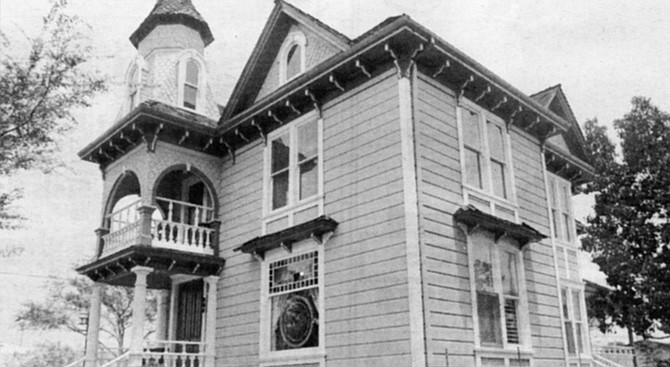
Read about San Diego architecture by Peter Jensen.
I drive down East Plaza Boulevard and at first pass a series of contemporary commercial buildings — a red Monterey-style Boll Weevil restaurant (“Home of the Steerburger!”); a glass, postmodern McDonald’s Play Place (“Toys and Fun Galore!"), a Spanish-Revival, earth-toned Family Loompya Seafood Market (“Scrumptious Fish on Sale!”)—and then I encounter a procession of bungalows. They are no different from their other National City brethren — modest, weather-beaten, with bars on their windows and doors.
August 28, 1997 | Read full article
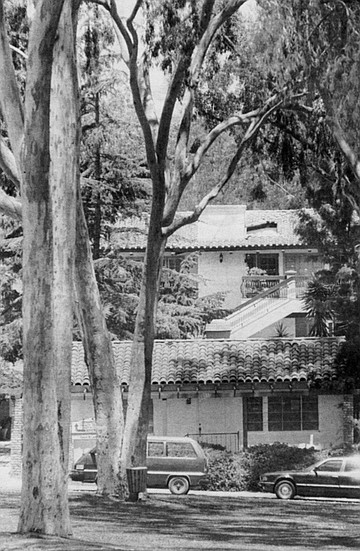
Cathy invites me to attend “Caravan,” an afternoon of “for-the-trade” open-house showings, during which agents inspect local inventory. We drive along Rancho's shaded thoroughfares, and I watch the glossy magazine photographs come to life — horse ranches, sprawling estates, orange groves, palm-lined drives. As a former Berkeleyite, I feel guilty ogling the properties. I know I should curl my lip and mutter about bourgeois excess, but the blue sky, scent of oranges, and nodding horses overpower this urge.
September 17, 1998 | Read full article
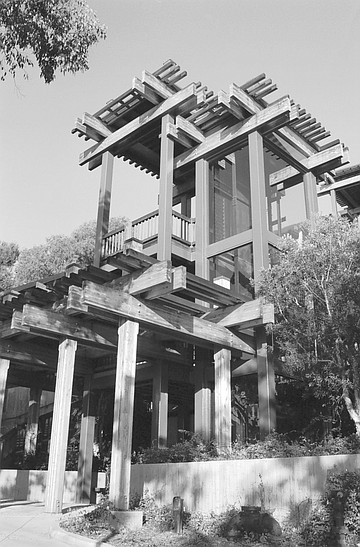
“Frankly, I think it's an incredible waste,” says one high-ranking UCSD administrator. “But the people who donate funds for such things probably wouldn’t redirect their money to things the college needs, like a mass spectrometer. Many of the sculptures are too modern, too freaky. They don’t appeal to those of us here who are conservative. For example, take that big 12-foot-high red-and-yellow shoe they put up [Elizabeth Murray's Red Shoe]. Give me a break..."
October 29, 1998 | Read full article
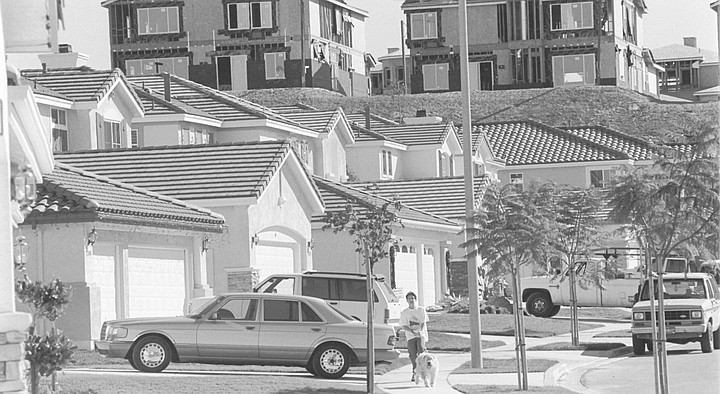
A solution that Lagoni admits is imperfect is the “third-car swing garage" — a space set at right angle to the house's facade. Yes, it is inconspicuous but unless one has a large lot, wide driveway, and a teeny vintage Metropolitan, ingress and egress is difficult. In newer Pardee communities, Rassenian & Lagoni have located some garages behind porte cocheres or in courtyards. Slowly, perhaps more slowly than one can angle a Cadillac sedan into a "third-car swing garage.”
April 15, 1999 | Read full article
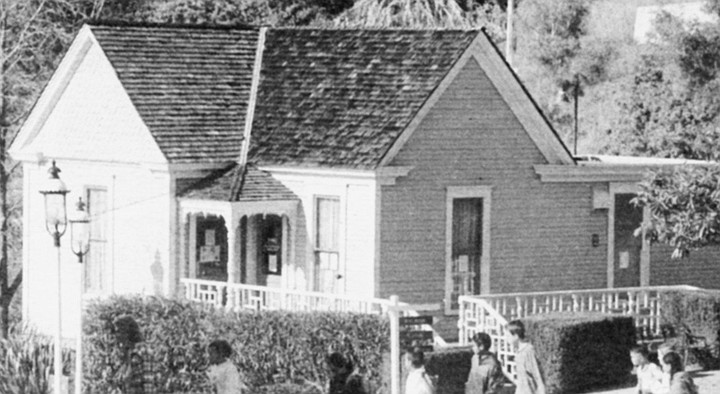
This Stick/Eastlake house, which stood at the southeast corner of Second and Fir, was designed by Comstock and Trotsche for John Sherman, a cousin of General William Tecumseh Sherman. From 1892 until 1965, the home was inhabited by sisters Bess and Gertrude Gilbert, who held receptions there for internationally famous entertainers such as Yehudi Menuhin, Anna Pavlova, Arthur Rubinstein, and Marian Anderson, who spent the night there after being denied lodging at the El Cortez Hotel during WWII.
July 1, 1999 | Read full article
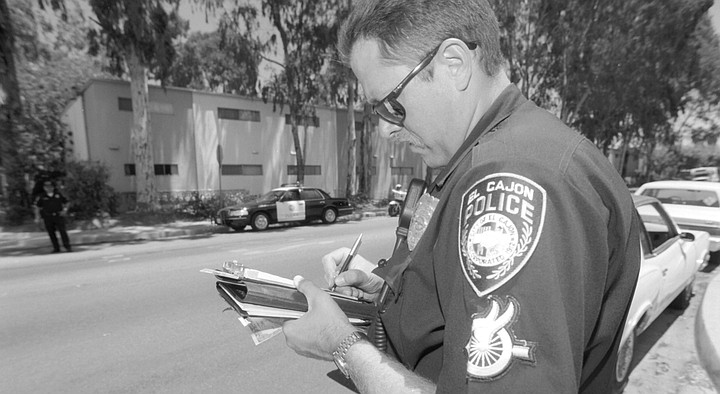
Before the 1950s, El Cajon had been a sleepy valley of citrus groves and vineyards. But a population stampede prompted developers’ bulldozers to raze the croplands to make room for hundreds of new families. This sudden change from agrarian to suburban vista put the EI Cajon Citrus Association, which had been operating since 1918, out of business. Between 1950 and 1960, El Cajon’s population increased by 623 percent. It became the second fastest-growing area in the state.
July 22, 1999 | Read full article
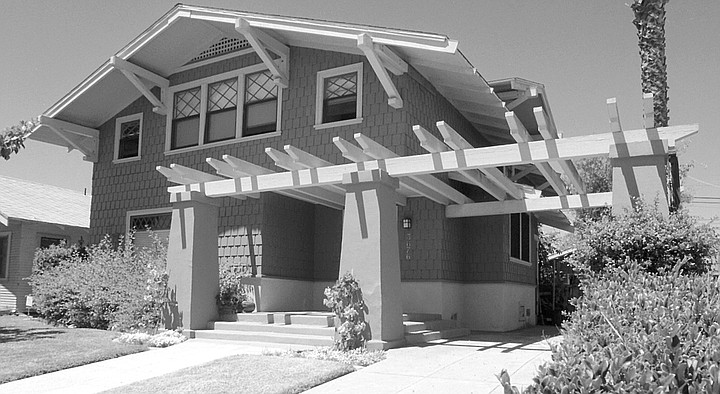
I’m a Boomer, and I’m tired of all the plastic. But Arts and Crafts zealots may have trouble finding furnishings and fixtures from the period, he warns. “Antique shops here are pretty devoid of it, because it’s been gobbled up so quickly. I believe a lot of Arts and Crafts furniture is locked up in the John Wayne generation’s closets. And I think a lot of them just don’t know what they have or what it’s worth.”
Nov. 4, 1999 | Read full article
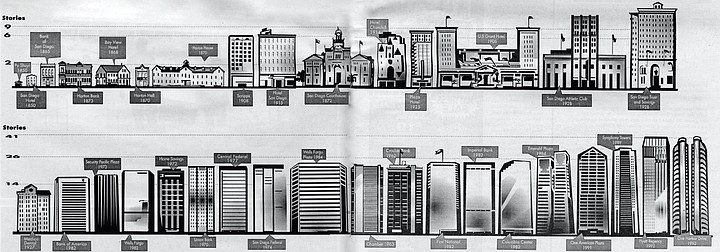
Perhaps the most significant structure erected downtown during this era was the 13-story San Diego Trust & Savings Bank built in 1928 at 530-540 Broadway, the 240-foot Italian Renaissance Revival structure became the county’s tallest commercial office high-rise. Its massive pillars, marble floors, and heroic arches emanated luxury and power. At a time when most buildings’ elevators traveled 300 feet per minute, the Trust & Savings Bank Building’s elevators ascended at an ear-popping 660 feet per minute.
March 30, 2000 | Read full article


Read about San Diego architecture by Peter Jensen.
I drive down East Plaza Boulevard and at first pass a series of contemporary commercial buildings — a red Monterey-style Boll Weevil restaurant (“Home of the Steerburger!”); a glass, postmodern McDonald’s Play Place (“Toys and Fun Galore!"), a Spanish-Revival, earth-toned Family Loompya Seafood Market (“Scrumptious Fish on Sale!”)—and then I encounter a procession of bungalows. They are no different from their other National City brethren — modest, weather-beaten, with bars on their windows and doors.
August 28, 1997 | Read full article

Cathy invites me to attend “Caravan,” an afternoon of “for-the-trade” open-house showings, during which agents inspect local inventory. We drive along Rancho's shaded thoroughfares, and I watch the glossy magazine photographs come to life — horse ranches, sprawling estates, orange groves, palm-lined drives. As a former Berkeleyite, I feel guilty ogling the properties. I know I should curl my lip and mutter about bourgeois excess, but the blue sky, scent of oranges, and nodding horses overpower this urge.
September 17, 1998 | Read full article

“Frankly, I think it's an incredible waste,” says one high-ranking UCSD administrator. “But the people who donate funds for such things probably wouldn’t redirect their money to things the college needs, like a mass spectrometer. Many of the sculptures are too modern, too freaky. They don’t appeal to those of us here who are conservative. For example, take that big 12-foot-high red-and-yellow shoe they put up [Elizabeth Murray's Red Shoe]. Give me a break..."
October 29, 1998 | Read full article

A solution that Lagoni admits is imperfect is the “third-car swing garage" — a space set at right angle to the house's facade. Yes, it is inconspicuous but unless one has a large lot, wide driveway, and a teeny vintage Metropolitan, ingress and egress is difficult. In newer Pardee communities, Rassenian & Lagoni have located some garages behind porte cocheres or in courtyards. Slowly, perhaps more slowly than one can angle a Cadillac sedan into a "third-car swing garage.”
April 15, 1999 | Read full article

This Stick/Eastlake house, which stood at the southeast corner of Second and Fir, was designed by Comstock and Trotsche for John Sherman, a cousin of General William Tecumseh Sherman. From 1892 until 1965, the home was inhabited by sisters Bess and Gertrude Gilbert, who held receptions there for internationally famous entertainers such as Yehudi Menuhin, Anna Pavlova, Arthur Rubinstein, and Marian Anderson, who spent the night there after being denied lodging at the El Cortez Hotel during WWII.
July 1, 1999 | Read full article

Before the 1950s, El Cajon had been a sleepy valley of citrus groves and vineyards. But a population stampede prompted developers’ bulldozers to raze the croplands to make room for hundreds of new families. This sudden change from agrarian to suburban vista put the EI Cajon Citrus Association, which had been operating since 1918, out of business. Between 1950 and 1960, El Cajon’s population increased by 623 percent. It became the second fastest-growing area in the state.
July 22, 1999 | Read full article

I’m a Boomer, and I’m tired of all the plastic. But Arts and Crafts zealots may have trouble finding furnishings and fixtures from the period, he warns. “Antique shops here are pretty devoid of it, because it’s been gobbled up so quickly. I believe a lot of Arts and Crafts furniture is locked up in the John Wayne generation’s closets. And I think a lot of them just don’t know what they have or what it’s worth.”
Nov. 4, 1999 | Read full article

Perhaps the most significant structure erected downtown during this era was the 13-story San Diego Trust & Savings Bank built in 1928 at 530-540 Broadway, the 240-foot Italian Renaissance Revival structure became the county’s tallest commercial office high-rise. Its massive pillars, marble floors, and heroic arches emanated luxury and power. At a time when most buildings’ elevators traveled 300 feet per minute, the Trust & Savings Bank Building’s elevators ascended at an ear-popping 660 feet per minute.
March 30, 2000 | Read full article
Comments